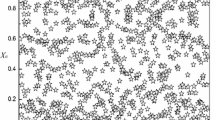Abstract
Aiming at shortening the design period and improve the design efficiency of the nose shape of high speed trains, a parametric shape optimization method is developed for the design of the nose shape has been proposed in the present paper based on the VMF parametric approach, NURBS curves and discrete control point method. 33 design variables have been utilized to control the nose shape, and totally different shapes could be obtained by varying the values of design variables. Based on the above parametric method, multi-objective particle swarm algorithm, CFD numerical simulation and supported vector machine regression model, multi-objective aerodynamic shape optimization has been performed. Results reveal that the parametric shape design method proposed here could precisely describe the three-dimensional nose shape of high speed trains and could be applied to the concept design and optimization of the nose shape. Besides, the SVM regression model based the multi-points criterion could accurately describe the non-linear relationship between the design variables and objectives, and could be generally utilized in other fields. No matter the simplified model or the real model, the aerodynamic performance of the model after optimization has been greatly improved. Based on the SVR model, the nonlinear relation between the aerodynamic drag and the design variables is obtained, which could provide guidance for the engineering design and optimization.























Similar content being viewed by others
References
Cui K, Wang XP, Hu SC et al (2012) Shape optimization of high-speed train with the speed of 500 kph. Lecture notes in electrical engineering. In: Proceedings of the 1st international workshop on high-speed and intercity railways, vol. 148. Springer, Heidelberg, pp 187–197
Hu X, Eberhart R (2002) Multi-objective optimization using dynamic neighborhood particle swarm optimization. In: Proceedings of the IEEE CEC. pp 1667–1681
Jongsoo Lee JK (2008) Approximate optimization of high-speed train nose shape for reducing micropressure wave. Ind Appl 35:79–87
Kennedy J, Eberhart RC (1995) Partical swarm optimization. In: Proceeding of the 1995 IEEE international conference on neural network, Perth, pp 1942–1948
Krajnovic S (2009) Shape optimization of high-speed trains for improved aerodynamic performance. Proc Inst Mech Eng Part F 223(5):439–452
Krajnovic S, Helgason E, Hafsteinsson H (2012) Aerodynamic shape optimization of high-speed trains. In: Proceedings of the first international conference on railway technology: research, development and maintenance, civil-comp press, Stirlingshire
Ku Y-C, Rho J-H, Yun S-H et al (2010a) Optimal cross-sectional area distribution of a high-speed train nose to minimize the tunnel micro-pressure wave. Struct Multidisc Optim 42:965–976
Ku Y-C, Kwak M-H, Park H-I, Lee D-H (2010b) Multi-objective optimization of high-speed train nose shape using the vehicle modeling function. In: 48th AIAA aerospace sciences meeting, Orlando
Li X (2003) A non-dominated sorting particle swarm optimizer for multiobjective optimization. In: Proceeding of genetic and evolutionary computation GECCO 2003: genetic and evolutionary computation conference, Springer, Berlin, pp 37–48
Moore J, Chapman R (1999) Application of particle swarm to multi-objective optimization. Department of Computer Science and Software Engineering, Auburn University, Auburn
Parsopoulos KE, Vrahatis MN (2002) Particle swarm optimization method in multiobjective problems. In: Proceedings of the ACM symposium on applied computing. Madrid, pp 603–607
Parsopoulos KE, Tasoulis DK, Vrahatis MN (2004) Multiobjective optimization using parallel vector evaluated particle swarm optimization. In: Proceedings of the IASTED international conference on artificial intelligence and applications (AIA 2004), vol 2. ACTA Press, Innsbruck, pp 823–828
Peng X (2010) TSVR: an efficient twin support vector machine for regression. Neural Netw 23(3):365–372
Rho JH, Ku YC, Yun SH et al (2009) Development of vehicle modeling function for 3-dimensional shape optimization. J Mech Des 131(12):121004-1-10
Shao YH, Zhang CH, Yang ZM et al (2013) An ε-twin support vector machine for regression. Neural Comput Appl 23(1):175–185
Yao S, Guo D, Yang G (2012a) Three-dimensional optimization design of high-speed train nose based on GA-GRNN. Sci China Technol Sci 55(11):3118–3130
Yao S, Guo D, Sun Z et al (2012b) Multi-objective optimization of the streamlined head of high-speed trains based on the Kriging model. Sci China Technol Sci 55(12):3494–3508
Yao S, Guo D, Sun Z et al (2014) Optimization design for aerodynamic elements of high speed trains. Comput Fluids 95:56–73
Vapnik VN (1998) Statistical learning theory. Wiley, New York
Vytla VV, Huang PG, Penmetsa RC (2010) Multi objective aerodynamic shape optimization of high speed train nose using adaptive surrogate model. In: AIAA-2010-4383
Acknowledgments
This work was supported by 973 program under 2011CB711100 and National Natural Science Foundation of China under 11302233. And Computing Facility for Computational Mechanics Institute of Mechanics, Chinese Academy of Sciences is gratefully acknowledged.
Author information
Authors and Affiliations
Corresponding author
Rights and permissions
About this article
Cite this article
Yao, S.B., Guo, D.L., Sun, Z.X. et al. Parametric design and optimization of high speed train nose. Optim Eng 17, 605–630 (2016). https://doi.org/10.1007/s11081-015-9298-6
Received:
Revised:
Accepted:
Published:
Issue Date:
DOI: https://doi.org/10.1007/s11081-015-9298-6




